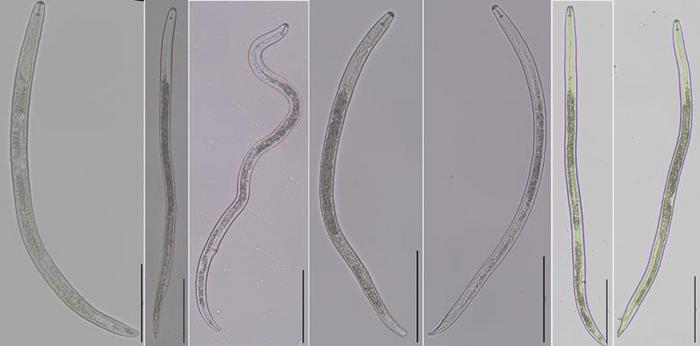
A recent investigation sheds light on the complex dynamics of root-lesion nematodes found in maize fields across New Zealand, revealing the presence of five distinct species of the genus Pratylenchus. This research not only delineates the species involved but also raises questions regarding a potential cryptic species, thus adding depth to our understanding of these agricultural pests. Such discoveries could have significant repercussions for pest management strategies aimed at safeguarding maize production, a crop that is vital to the country’s agricultural framework.
The study published in the eminent journal Letters in Applied Microbiology undertakes a thorough molecular characterization of root-lesion nematodes, focusing on their prevalence in various maize-growing regions. Lead author Dr. Nagarathnam Thiruchchelvan emphasizes the relevance of identifying these nematodes for formulating effective pest management approaches. He notes that root-lesion nematodes are known for their polyphagous nature, making them a considerable threat to various crops, particularly maize, which is a staple for both human consumption and livestock feed.
Within the scope of this study, the researchers deployed a combination of molecular and morphological techniques to assess nematode populations collected from New Zealand’s diverse maize fields. They employed advanced DNA sequencing methods, targeting regions such as ITS, LSU (D2/D3), and COX1, which enabled them to catalogue and identify the five species in focus: Pratylenchus neglectus, Pratylenchus crenatus, Pratylenchus thornei, Pratylenchus penetrans, and Pratylenchus pratensis. The sequence similarities within these species ranged from an impressive 98% to 100%, solidifying their identification through phylogenetic analyses that demonstrated distinct clades for each species.
Dr. Thiruchchelvan’s research reveals that the most widespread species, P. neglectus and P. crenatus, were found across many maize fields, whereas P. thornei, P. pratensis, and P. penetrans appeared to be more regionally confined. This underscores the importance of considering soil characteristics and cropping history when investigating these nematodes. Soil type, in particular, was identified as a significant determinant in the distribution of these species; for instance, P. penetrans was predominantly found in the Waikato region, while P. thornei and P. pratensis were primarily localized to the Canterbury area.
Interestingly, the morphological analyses presented some unexpected findings, particularly concerning the P. pratensis populations. Certain traits, such as variations in stylet length and tail morphology, suggested that these populations may represent a cryptic species within the closely related P. pratensis complex. This revelation implies that the nematode populations in question exhibit genetic and functional diversity that could have hitherto gone unrecognized.
Dr. Thiruchchelvan commented on the implications of these findings, stating that identifying the species and understanding their distribution is pivotal for the implementation of effective pest management strategies. He highlighted the economic stakes involved, as root-lesion nematodes can significantly reduce cereal yields—an aspect that can destabilize food supply chains and impact farmers’ livelihoods.
Not only does this study implicate the existing nematode populations in yield reduction, but it opens the door for future research to uncover their influence on maize ecology. This could involve investigating the exact mechanisms by which these nematodes affect plant health and growth, as well as their interactions with beneficial soil microbes that could alleviate their detrimental impacts.
Moreover, the potential existence of cryptic species emphasizes an urgent need for continued monitoring of these nematodes. Without vigilant observation and proactive management strategies, agriculture in New Zealand could face new pest challenges that threaten not only maize but potentially other crops as well. This stresses the idea that agricultural practices must adapt in response to emerging evidence regarding pest populations, possibly integrating crop rotation and enhancing soil health practices to mitigate the risk posed by these pests.
In light of the discoveries made, Dr. Thiruchchelvan advocates for expanded morphological and molecular analyses to confirm the taxonomic status of the P. pratensis populations found in the study. He suggests that such efforts could reveal whether these populations constitute a distinct species or represent phenotypic variations within an established species. It is also proposed that root sampling ought to be an integral part of nematode surveys to gain a comprehensive understanding of their ecological roles within maize fields.
The study stands as a significant contribution to our current understanding of nematodes and their impact on agriculture. Furthermore, it highlights the collaboration between various researchers under the guidance of seasoned supervisors, culminating in valuable insights backed by rigorous scientific methods. Such academic endeavors are essential not just for immediate agricultural concerns but also for the long-term sustainability of farming practices in New Zealand and beyond.
Dr. Thiruchchelvan’s research illustrates an important intersection between molecular biology and practical agricultural science. By elucidating the diversity and distribution of root-lesion nematodes, this investigation strives to inform effective pest management strategies that could ultimately contribute to enhanced agricultural productivity and food security.
In summary, this recent study signifies an important stride in the realm of agricultural nematology while also calling attention to the pressing need for ongoing research. The complexities of the Pratylenchus species may hold keys to better understanding pest behavior and overcoming agricultural challenges posed by these nematodes. With future studies poised to illuminate further nuances in nematode populations, the agricultural sector must remain vigilant and responsive to these findings.
Subject of Research: Root-lesion nematodes in maize fields
Article Title: Molecular characterization of root-lesion nematode, Pratylenchus species, and their prevalence in New Zealand maize fields
News Publication Date: 24-Dec-2024
Web References: Letters in Applied Microbiology
References: N/A
Image Credits: Nagarathnam Thiruchchelvan
Keywords: Microbiology, Agriculture, Pest control, Sustainable agriculture, Farming, Ecology, Genetics, Microbial genetics





